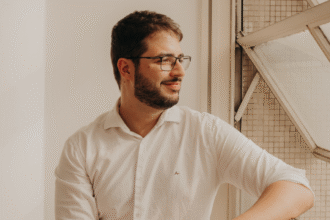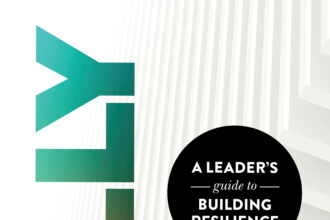In “Looking for Wonderland”, a series of five books written by Joaquim Coelho , a young Brazilian comes across an intriguing urban legend upon entering Oxford University: the possible existence of an unpublished third volume of Alice in Wonderland. Wonders, written by Lewis Carroll. Martin Roque, the protagonist, embarks on a dangerous journey to unravel the mystery, alongside a group of friends equally fascinated by the literary classic. The series, which mixes suspense, magical realism and literary references, promises to involve readers in a plot full of enigmas, secret societies and a serial killer on the loose on campus. With the release of the last volume scheduled for 2025, the saga is already established as a tribute to human curiosity and Carroll’s work.
What inspired you to create the “Looking for Wonderland” series and how did the idea of connecting the plot with the legend of a third volume by Lewis Carroll come about?
hyperfocused child in Alice in Wonderland. At my mother’s house, in my hometown, there was a time when I had almost 60 different editions of the same book. I also had a habit of collecting objects that referred to history: I had boxes full of old keys, pocket watches, playing cards, cups… I grew up with history fueling my imagination and creativity. There came a time when I got tired of rereading the same story and started researching the author and how the book came about, perhaps out of a desire to understand this magic in the story that enchanted me so much. That’s when I discovered that Lewis Carroll’s life was full of mysteries and loose ends that still need explanations today: he was a cryptographer, a super-rational and logical exact guy who, for some reason, was obsessed with the supernatural; he disappeared with his own diaries, there are several intentional holes he created in his biography; and he also had a habit of hiding “treasures” in the places where he lived. At the same time, as a teenager, I became fascinated with thrillers, especially those involving conspiracies and enigmas, like Dan Brown’s books, in which characters go on a treasure hunt, visit tourist attractions and discover interesting facts about art and history. One influence mixed with the other and the first book in the series was born in a few months, the result of mere passion and inspiration.
How did you develop the characters Martin Roque, Nicole Fialho, Lucas and Sabrina, and how important is each one in solving the story’s mysteries?
This is a brave question, since all the characters in the series hide secrets that are bombastic spoilers if I start talking about their dramatic arcs. But one thing I always had in mind when creating them was the fact that they were perfect for solving the mystery of Carroll’s life: Martin is a literary scholar obsessed with understanding his favorite book and author; Nicole is a history student; Sabrina is into theology, she knows everything about the occult and the supernatural; Lucas is already the rational force of the group, very logical and skeptical. They all represent, to a greater or lesser extent, the various facets of the author of Alice, his interests and personality. But other than that, I do my best to make them three-dimensional. All the characters are motivated by past losses and traumas, and these internal problems are gradually revealed in a way that causes conflict and, of course, a lot of entertainment in the plot.
Can you tell us more about the research and historical and literary details you included in the series? How do these elements enrich the narrative?
I generally use historical and literary details as a way to move the plot and create obstacles. Much of the plot works like a treasure hunt, the characters need to decipher clues left by Lewis Carroll in order to find artifacts or important locations. These clues — and their resolution — are always linked to some historical curiosity about Alice. I’m going to give a spoiler: “Lewis Carroll” is not the writer’s real name, his name was Charles Dodgson ; he created this pseudonym not only as a way to distance himself from fame, but also because he stuttered and could not pronounce his full name. He always got stuck on the initial syllable of Dodgson and ended up saying Do-do . This ended up giving rise to the character of the Dodo bird, it was Carroll’s self-insertion into his own story. In Oxford there is also an ancient stuffed Dodo (which Carroll saw during an exhibition at the local museum in the company of Alice Liddell , the real girl who inspired the protagonist). In my series, the characters are given a clue that there is something important hidden “inside Dodgson ‘s head ”. And, through this research, they end up understanding that, in fact, Lewis Carroll hid something in the head of the college’s stuffed Dodo. My goal with this is not only to generate entertainment, but also to bring education and culture to the reader. It is speculated that Carroll, as a teacher and living at a time when education was not yet a right for everyone (much less for girls, with whom he maintained many friendships), wrote Alice as a way of subliminally educating on various subjects. When reading In Search of Wonderland, these issues are exposed to the reader. We learn not only about curiosities about the writer’s creative process, but also about the mathematics, philosophy and science that are infused in his works.

The series combines elements of mystery, suspense and magical realism. How do you balance these genres to create a cohesive and engaging experience for readers?
I always tell myself that Finding Wonderland is primarily a mystery series. Even when the plot gets bold and ventures into other genres (SPOILER BOOK 4 AND 5: in the last volume released, the characters were in Wonderland itself, which, yes, is a real place in this universe END OF SPOILER), the Narrative structure still remains investigative in nature. Each volume begins with cliffhangers that are open-ended and don’t make much sense initially, but as the plot progresses, these gaps are filled in and explained through twists and discoveries made by the protagonists, just as they would be in a traditional book. mystery.
What was the biggest challenge when writing the riddles and codes that readers can unravel alongside the characters?
So far I haven’t had many challenges. Creating puzzles and codes is something that comes naturally to me. I think my biggest difficulty is more in how to make the codes always relevant to the progression of the plot and fit them together in a natural way.
How did you create the secret society of the Carrollians and the antagonist known as the Queen of Hearts? How important are these elements in the plot?
You want me to give spoilers, right? Is it supposed to be a spoiler here? Have you read the books? Your questions make it seem so. Talking directly about this would involve telling the entire story of 5 books. If I’m going to give a brief, spoiler-free answer, I created it to generate tension in the plot. Of course, their role in the story goes beyond that, but talking too much about it would involve having to say who the killer is, for example. My intention with this character was to reinforce the series’ message about being careful what you wish for and the consequences of getting carried away too much by curiosity and ambition.

Can you share any interesting details or curiosities about the creation of the sets and settings at Oxford University that appear in the series?
When you study Carroll you see that almost all of his influences are present in Oxford. The little door that Alice goes through to get to the Jardim da Rainha de Copas is actually a small door that connects the college to the gardens of the Church of Christ. Church . The scenes in which Alice’s neck stretches and increases in size when she eats or drinks something is a reference to the experience of dining in the college cafeteria – when students and professors eat there they often watch the firewalls. in fireplaces that are shaped like heads with long necks. [SPOILER FOR BOOK 4]: When Lewis Carroll was a child, his father was responsible for looking after a cathedral in Ripon where there are sculptures of rabbits in their holes. The same church also has a crypt with a corridor that widens as you cross it, creating an optical illusion in which it appears that you are shrinking in size. In my series, Ripon turns out to be the place where the entrance to Wonderland is hidden. And Carroll’s father ended up being reimagined as a member of a secret society that watched over the cathedral in order to protect the rabbit hole beneath it in the crypt. [END OF SPOILER]. I try to be as faithful as possible to the actual locations, but as I’ve never been to Oxford in person, my descriptions are limited to images from Google Street View , YouTube videos and other people’s descriptions I’ve read in research. I’m not always 100% faithful, sometimes I purposely change the facts a little (or a lot) to suit the needs of the story. I never allow my creativity to be limited by reality.
What do you hope readers take away from In Search of Wonderland when they finish the series? Is there a specific message or feeling you would like to convey?
I’m in love with this question because I’m writing the last volume of the series right now and it’s always on my mind. In Search of Wonderland has always been a cautionary tale, a narrative designed to warn. In this case, about the consequences of excessive ambition and curiosity, but without generalizing or bringing intellectualism as a villain (the characters usually manage to get out of trouble because they are also know-it-alls). Throughout the series we see Martin make impulsive decisions simply by following his insatiable curiosity and this ends up bringing many, many, MANY disastrous consequences for him, his friends and the entire world. The entire story will culminate in a fateful and irreparable consequence for the protagonist. Turning this into a psychoanalysis session, I feel that Martin’s journey reflects my own a little: trying to follow an ambition to write a 6-volume series (most people struggle their entire lives to finish a single book) that has already lasted longer of a decade, pursue an artistic career and, in the process, research and study a lot about all these subjects. During this decade I realized that intense study, curiosity and dedication are edifying, but also the more you know, the higher your ambition, the more it distances you from people and generates a different type of alienation and isolation. You stop understanding how to do simple things, like having friends and connecting with others. Having desires and dreams is important, but we must not allow them to suppress our social relationships. A balance between intellectuality and humanity is necessary. It may not be such a universal message – I recognize that it sounds “niche” and hermetic – but it is what I feel the story has to offer and it is on this note that it ends.
Follow Joaquim Coelho on Instagram





